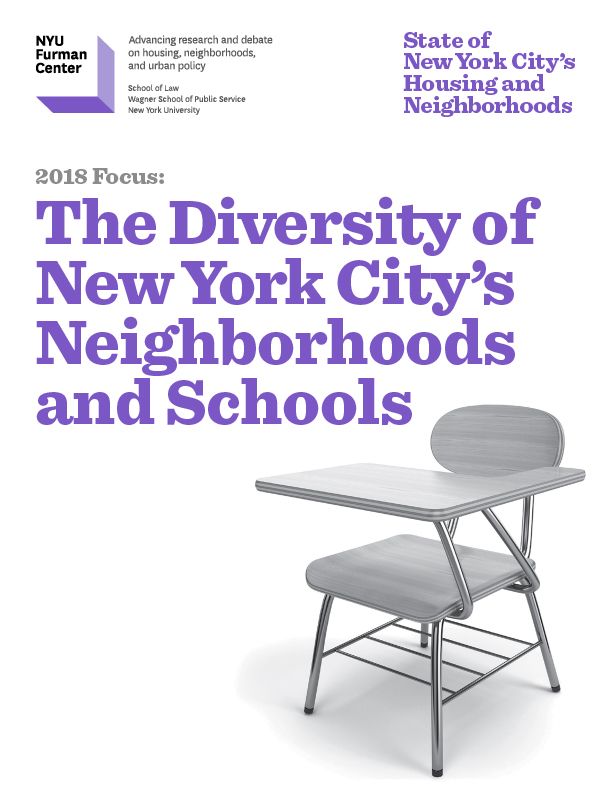
REPORT: Uneven Progress in School Diversity as New York City’s Neighborhoods Experience Change

A new report from the NYU Furman Center, The Diversity of New York City’s Neighborhoods and Schools, examines the racial and ethnic diversity of the city’s neighborhoods and public elementary schools. The report finds evidence of progress--for example, the concentration of racial and ethnic groups has grown less extreme over the past 12 years for Black, Hispanic, and white students. Yet troubling trends persist: the city’s Black and Hispanic students remain significantly more racially isolated in schools with far higher economic needs than their white and Asian peers.
The report also examines how the racial and ethnic makeup of New York City’s public elementary schools differs from the city’s demographic makeup and reveals variations in economic need in different schools. Black and Hispanic students are far more likely to attend public elementary schools than white students, and Black-Hispanic schools (schools with at least 20% Black students and at least 20% Hispanic students) had, on average, the highest share of students in temporary housing (21.1%) and--along with predominantly Hispanic schools--the highest Economic Need Index (0.87). Predominantly white schools had, on average, the lowest share of students in temporary housing (2.2%) and the lowest Economic Need Index (0.24). More key findings from the report appear below.
The report was released as part of the NYU Furman Center's annual State of New York City’s Housing and Neighborhoods in 2018, which provides a rich compendium of data and analysis about the city's population, housing stock, rental market, and neighborhood conditions.
Read the new report: The Diversity of New York City’s Neighborhoods and Schools (PDF)
Read The State of New York City's Housing and Neighborhoods in 2018 or view the indicators on CoreData.nyc.
DISTRICT DIVERSITY PROFILES: To accompany the report, the NYU Furman Center published a set of interactive District Diversity profiles that contain statistics and demographic data on each of New York City’s school districts.
LAUNCH EVENT: To mark the launch of the report, the NYU Furman Center hosted an event, By the Numbers: The Diversity of New York City's Neighborhoods and Schools, on Tuesday, May 28, 2019 at the NYU Kimmel Center.
The Diversity of New York City’s Neighborhoods and Schools: Key Findings
- New York’s public school classrooms do not look like the city as a whole--while 3 in 10 New Yorkers overall and 1 in 4 children ages 5-9 are white, the share of white students enrolled in public school is less than 15 percent. Black and Hispanic students, on the other hand, are over-represented in public schools.
- Overall, 6 in 10 New York City public school students attend diverse schools--that is, schools where two different racial and ethnic groups constitute at least 20 percent of the student population.
- Black and Hispanic students are much more likely to share schools with each other than with any other racial or ethnic group. Roughly 9 in 10 Black students and 7 in 10 Hispanic students attend schools classified as Black-Hispanic, Predominantly Black, or Predominantly Hispanic.
- Roughly 7 in 10 white students and 8 in 10 Asian students attend schools where at least 20 percent of the school population is from a racial or ethnic group other than their own.
- Overall, 39 percent of New York City’s public elementary schools are predominantly one-race schools, 28 percent are Black-Hispanic schools, and 33 percent are other types of diverse schools.
- Predominantly white schools have an average Economic Need Index (an index that goes from 0 to 1 and captures the level of economic disadvantage of the student population) of 0.24, while predominantly Hispanic and Black-Hispanic schools have an average Economic Need Index of 0.87.
- Public elementary school students generally attended schools with fewer same-race peers in the 2017-18 school year than they did in the 2005-06 school year, with the exception of Asian students, who attended schools with more same-race peers in 2017-18 than in 2005-06.
- When the population of school zones diversified, their elementary schools diversified as well, but neighborhood diversification exceeded school diversification. For example, when a school zone with a small white population saw a gain in its white residential population share of at least 10 percentage points, the white student share rose on average by just 1.6 percentage points in the local elementary school.


